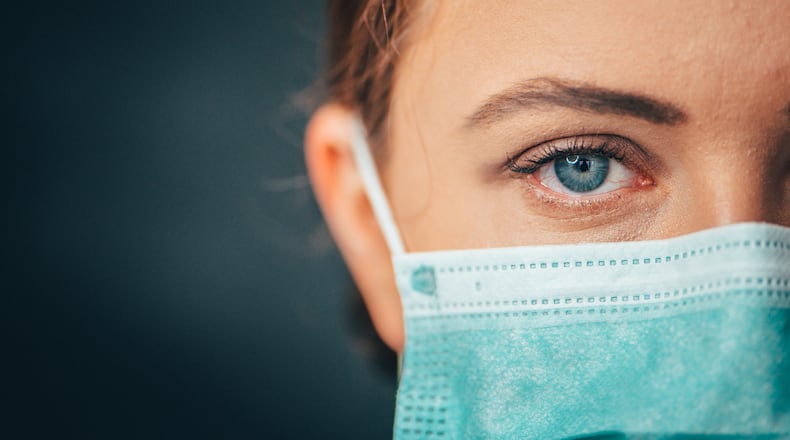“The concern for reducing disease transmission has led to a worldwide increase in face mask utilization,” researchers at the University of Utah wrote in a report published in the journal Ophthalmology and Therapy. “During this period, we have observed a corresponding increase in ocular irritation and dryness among regular mask users. This finding has not been previously described in the literature but has important implications on eye health and infection prevention, as mask use is likely to continue for the foreseeable future.”
The Centre for Ocular Research & Education also issued an alert to practitioners in August warning of mask-associated dry eye, or MADE. The Utah researchers noted an increase in dry eye symptoms among people who had never suffered from the condition previously.
“Individuals using masks regularly for an extended duration appear more likely to show symptoms,” they wrote. “This group includes the elderly, immunocompromised, and clinic staff who wear masks almost full-time.”
Why is this a problem?
“The majority of individuals described an awareness of air blowing upward from the mask into their eyes. This increased airflow likely accelerates the evaporation of the tear film which, when continuous for hours or days, may result in ocular surface irritation or inflammation,” the researchers wrote.
The tear film is an essential barrier against pathogens, and mask use could cause this barrier to evaporate more rapidly. Discomfort from dry eyes might also increase eye rubbing and face touching, leading to the spread of the coronavirus.
How can you prevent damage to your eyes?
The first step, experts say, is to ensure your mask fits properly. Masks with a pliable nose wire should be used, with attention toward fitting the shape of the wire to prevent air being directed toward the eyes. If you already own masks without nose wires, you can buy adhesive adjustable strips that will allow you to fit your mask better.
Next, if you find your eyes are getting dry, consider safely taking a break from wearing your mask if possible.
“Patients experiencing dry eye symptoms from extended mask wear should take breaks every few hours to remove the mask, allow the eyes to recover, and reapply lubricant eye drops,” the researchers wrote. “Emollient eye drops may be the most effective in preventing symptoms by preserving tear film. Blinking exercises may also be beneficial.”
At night, or whenever you are home and not needing a mask, place a warm or hot wet washcloth or compress on your eyes for a few minutes.
“This can help stimulate your eyelid’s Meibomian glands — which are responsible for the oily outer layer of your tears — and push more oil out of the glands,” Vivian Shibayama, an optometrist with UCLA Health, told Health. “And, with more oil in your tears, the lubrication on your eyes should be less likely to evaporate as quickly.”
What to know about dry eye
Dry eye is a condition that happens when the amount or quality of your tears isn’t sufficient, according to the National Eye Institute (NEI).
Dry eye is common — the NEI says it affects nearly 5 million Americans — and it can cause symptoms, including:
- A scratchy feeling, like there’s something in your eye
- Stinging or burning feelings in your eye
- Red eyes
- Sensitivity to light
- Blurry vision
Strategies for relief
The American Academy of Ophthalmology recommends:
• Take a quick break from screen time. Research has shown that when people look at screens they blink less or fail to blink completely, resulting in dry or irritated eyes.
• Keep wearing your mask.
• Find a mask that fits properly. An ill-fitting or poorly made face covering will increase the chances of improper airflow. A metal strip at the top of the mask can help control airflow.
• Take quick mask breaks when safe
• Use over-the-counter artificial tear drops without preservatives (not redness relievers)
• Resist the urge to rub your eyes.
• Use warm compresses for relief. Fill a bowl with warm water. Put a clean washcloth in it. Cover it completely. Wring it out so it’s damp but doesn’t drip. Fold the washcloth and place it on your eye. Leave it there for several minutes.
About the Author
